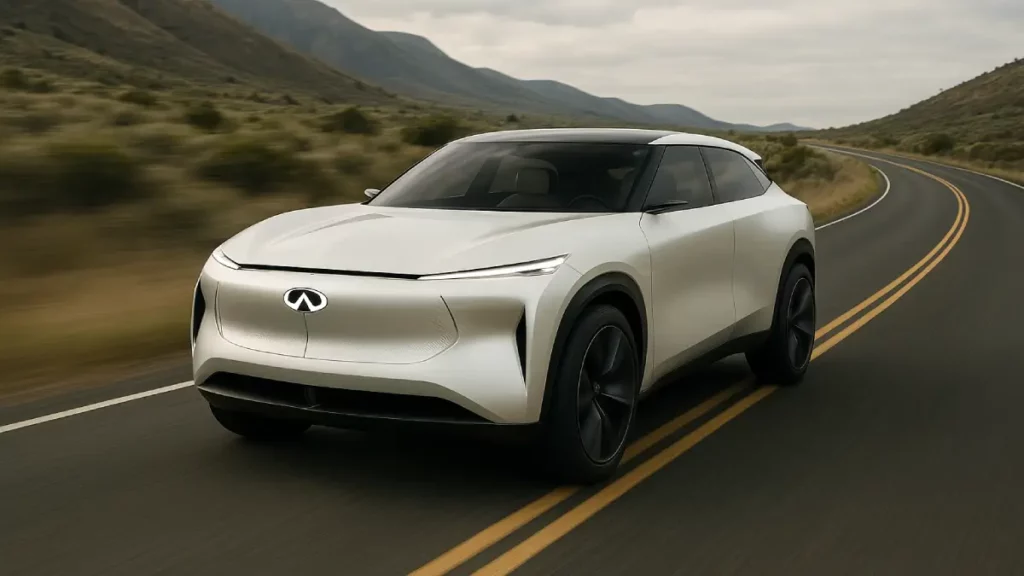
Estimated reading time: 8 minutes

Get ready for some super exciting car news! Have you heard of INFINITI? They make really fancy and cool cars, known as the luxury part of the Nissan family. Well, guess what? Big changes are coming! We’re going to dive deep into the world of Infiniti electric vehicles.
Right now, if you go looking for an INFINITI electric car, you won’t find one in the showrooms. But hold on, don’t click away! The future is closer than you think…
Even though they don’t have electric cars *today*, INFINITI has revealed some amazing plans. They are getting ready to launch some incredible new Infiniti electric vehicles very soon, and we’ve got all the scoop! They’ve shown off some ideas for what these future cars will look like, and trust us, they look awesome. It’s like getting a sneak peek into the future of driving!
Before we zoom ahead, let’s quickly talk about what an electric vehicle, or EV, is. Think of it like a toy car that runs on batteries, but much, much bigger and way more powerful! Instead of using gasoline like most cars today, electric cars use electricity stored in big batteries. You plug them in to charge them up, kind of like your phone or tablet.
Electric cars are often quieter, smoother to drive, and they don’t produce tailpipe pollution like gas cars, which is better for our air. Many people are excited about electric vehicles because they are seen as the future of driving.
INFINITI recently pulled the covers off something truly special: the Vision Qe concept car. What’s a concept car? It’s like a drawing or a model that shows what a future car *might* look like. And the Vision Qe gives us the very first look at INFINITI’s first-ever all-electric car!
This isn’t just any car; it’s a stunner! It’s designed as a “fastback sedan.” That means it has a sleek roofline that slopes down gently towards the back, making it look sporty and fast even when it’s standing still. INFINITI says the design is inspired by ideas from Japan, focusing on being smooth and cutting through the air easily. Imagine a car shaped like a smooth stone skipping over water – that’s kind of the idea! This smooth shape helps the car use less energy, so it can travel further on a single battery charge.
Imagine lights across the front and back that look like the keys on a piano, lighting up in cool patterns. Sounds futuristic, right? That’s the ‘digital piano key’ lighting on the Vision Qe!
But the cool stuff doesn’t stop there. The Vision Qe has some really neat lights. INFINITI calls them “digital piano key” lights. Imagine lights across the front and back that look like the keys on a piano, lighting up in cool patterns. It sounds futuristic and very stylish!
And check out the wheels! They are huge and have a special pattern on them. INFINITI says the design is inspired by the look of electric motor coils – the parts that make an electric car go. It’s a cool way to hint at the electric power hiding underneath.
So, when can we actually drive something like this? INFINITI expects that the real car based on the Vision Qe concept will start being made around the year 2025. That’s not too far away! This car promises to bring INFINITI’s famous luxury feel into the exciting world of electric vehicles.
The Vision Qe sedan is super exciting, but INFINITI isn’t stopping there. They have plans for even more electric models! At a special event called “New Dawn,” INFINITI showed off more ideas for their electric future. Let’s take a look:
It’s clear that INFINITI is planning a whole family of new vehicles, with electric power playing a huge role! From sleek sedans to versatile SUVs, they seem to be covering all the bases.
Okay, we’ve seen the cool concepts and heard about the plans. But the big question is: when can we actually see these Infiniti electric vehicles on the road?
INFINITI has given us some clues about their timeline. Get ready, because the first electric vehicles from INFINITI are expected to launch around the year 2025 (Source 1, Source 2). This matches up with the timing mentioned for the production version of the Vision Qe concept. So, in just a couple of years, we might start seeing these exciting new electric cars driving around!
But INFINITI has an even bigger goal. They are aiming to have all their car models “electrified” by the end of this decade – that means by around 2030. What does “electrified” mean? It could mean fully electric like the Vision Qe and QXe concepts, or it might include other types of cars that use electricity in some way, like hybrids (which use both gasoline and electricity). Either way, it shows that INFINITI is serious about moving away from traditional gasoline-only cars and embracing electric power across their entire range. This is a huge step and shows how quickly the car world is changing!
Making cool-looking electric cars is one thing, but they also need amazing technology inside. And INFINITI seems to be working on some really advanced stuff, thanks to their parent company, Nissan.
Nissan has teamed up with a very smart partner: NASA! Yes, the space agency! Together, they are working on developing next-generation battery technology for electric vehicles.
Imagine charging your EV fully in just 15 minutes! That’s the potential future Nissan and NASA are working towards with advanced battery tech. Game changer? Absolutely.
One of the exciting things they are researching is something called “all-solid-state batteries”. What’s so special about these? Well, current EV batteries use liquid parts inside, but solid-state batteries, as the name suggests, use solid materials. This could make them much safer, lighter, and smaller than today’s batteries. Imagine batteries that are less likely to have problems, weigh less (which helps the car go further), and take up less space (leaving more room for people or luggage!). This is cutting-edge stuff!
But wait, there’s more! They are also working hard to make EV charging much, much faster. We all know it can take a while to charge an electric car right now. But Nissan and NASA are trying to create batteries that could fully charge in just 15 minutes! Wow! Imagine stopping for a quick break and having your car fully charged and ready to go again in the time it takes to grab a snack. That would make owning an electric car even easier and more convenient.
While this super-advanced tech might still be a few years away from being in cars you can buy, it shows that INFINITI and Nissan are thinking ahead and working on making their future electric vehicles some of the best on the road. This commitment to battery technology is crucial for making EVs appealing to more drivers.
You might be wondering why INFINITI, a brand known for its powerful gasoline engines and luxurious feel, is making such a big shift towards electric cars. Well, there are a few big reasons.
Firstly, the whole world is moving towards electric vehicles! Many countries have set goals to reduce pollution, and electric cars are a big part of that plan. Car buyers are also getting more interested in EVs because of their environmental benefits, quiet ride, and often lower running costs (electricity can be cheaper than gas, and EVs need less maintenance). INFINITI wants to be part of this future.
Secondly, other luxury car brands are already selling amazing electric cars. Brands like Tesla, Rivian, Lucid, BMW, Mercedes-Benz, and Audi have popular luxury EVs. To keep up and offer what luxury buyers are looking for, INFINITI needs to have its own exciting luxury EVs.
Thirdly, electric power fits perfectly with luxury cars. Electric motors provide instant power, making the cars feel quick and responsive. They are also very quiet and smooth, which adds to the feeling of luxury and comfort inside the car. INFINITI can combine its skill in making beautiful, comfortable interiors with the benefits of electric driving to create something truly special.
INFINITI is bringing its unique style – seen in the Vision Qe and QXe concepts – to the electric world. They plan to offer the performance, comfort, and technology that luxury buyers expect, but with clean, electric power. It’s about blending their heritage with the future of driving.
The launch of Infiniti electric vehicles is part of a much bigger trend. Electric cars are becoming more common every day. You probably see more Teslas, Mustang Mach-Es, Hyundai IONIQ 5s, and other EVs on the roads now than ever before.
As more companies like INFINITI jump into the EV market, it means more choices for car buyers. It also helps push the technology forward, leading to better batteries, longer driving ranges, and more available EV charging stations. Finding a place to charge your electric car is becoming easier all the time, with charging stations popping up in shopping centers, parking lots, and along highways.
Owning an EV has lots of perks. Besides being better for the environment, they can be cheaper to run. Electricity costs often vary, but can be less than gasoline per mile driven. Plus, EVs have fewer moving parts than gasoline cars (no oil changes needed!), which can mean lower maintenance bills. And many drivers love the quiet, smooth, and zippy driving experience.
So, while INFINITI doesn’t sell any electric cars right this minute, the future is definitely electric for this luxury brand! We got a thrilling look at the Infiniti electric vehicles coming our way with the sleek Vision Qe sedan concept and the promising Vision QXe electric SUV concept.
Remember these key takeaways:
The journey towards Infiniti electric vehicles is just beginning, and it looks incredibly exciting. With stunning designs, promises of luxury and performance, and cutting-edge technology in the works, INFINITI is getting ready to make a big splash in the electric car world. Keep your eyes peeled – the electric dawn for INFINITI is coming soon! We can’t wait to see these amazing cars hit the road.
Q: Does Infiniti sell electric cars right now?
A: No, as of late 2023 / early 2024, Infiniti does not have any fully electric vehicles available for purchase in showrooms.
Q: When will the first Infiniti EV be available?
A: Infiniti expects its first all-electric vehicle, likely based on the Vision Qe sedan concept, to begin production and launch around 2025.
Q: What types of electric vehicles is Infiniti planning?
A: Infiniti has shown concepts for an electric fastback sedan (Vision Qe) and an electric SUV (Vision QXe). They are also planning other new models like the QX65 crossover coupe as part of their future lineup.
Q: What is “electrification” by 2030?
A: This means Infiniti aims for its entire range of vehicles to incorporate electric power by 2030. This could include fully electric models (BEVs) as well as potentially hybrids (HEVs) or plug-in hybrids (PHEVs).
Q: What advanced EV technology is Infiniti working on?
A: Through Nissan and its partnership with NASA, work is underway on next-generation batteries, potentially including safer, lighter all-solid-state batteries and technology aiming for significantly faster charging times (like 15 minutes).
Do you know what is Hydrogen Fuel Cell Vehicles: Revolutionizing the Future of Green Transportation ?